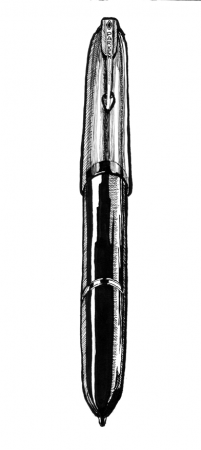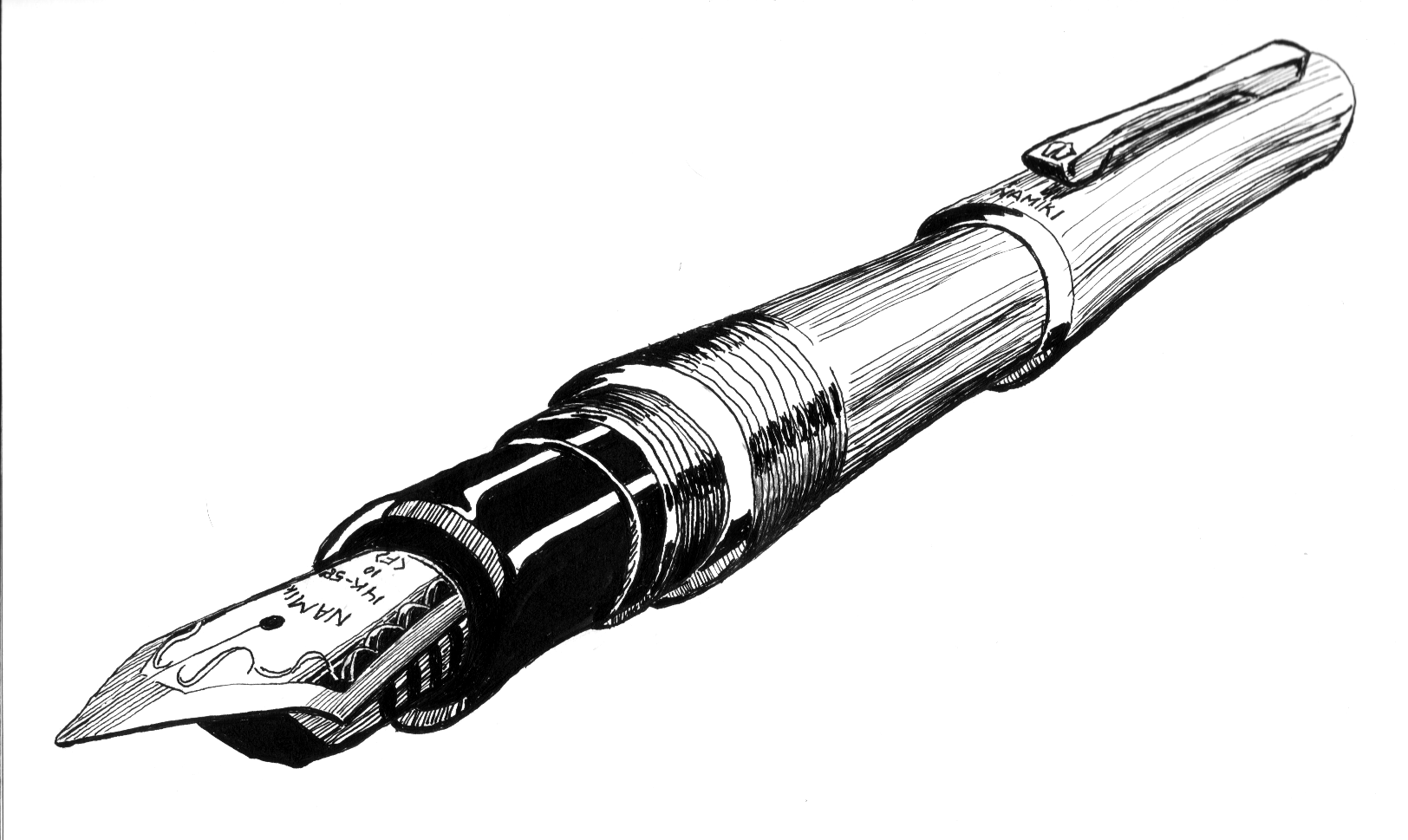
Choosing Your First Fountain Pen
This article first appeared in All This Is Mine issue #12 and appears here as it did in print, with the exception of minor factual and typographical corrections.
In the published version, I described the nib size «Extra-Broad» or «EB». The more common designation is «Double-Broad» and commonly abbreviated «BB». I also amended the designation for «Extra-Fine» to include the abbreviation «XF» in addition to «EF». Both are in common use. Punctuation has been changed to fit splicer.com’s stylebook, and link/URL presentation which was not possible on paper. Illustrations are different from those that appeared in print.
While there is a lot to know about fountain pens, you don’t need to know a lot. Just write with the nib right side up and don’t push down too hard. It takes only a light touch to make the ink flow, and some more flexible pens can easily be damaged if you apply too much pressure. Got that? Great! Now you’re an expert! Let’s pick out a pen for you.
Although it would be a cop out to just pick one for you (what would I do with the rest of the page?) I will make one specific recommendation: the Pilot Varsity. To my knowledge, it is the only disposable fountain pen on the market. You can get them for a few bucks at most office supply stores. They don’t require you to fuss with ink or cartridges and they write really well. If you want to get a taste of the fountain pen experience without much commitment, the Varsity is a great place to start.
There are, however, other factors to consider if you’d like to choose a pen that will suit you. Preferences are learned over time, but I’ll help you to fast forward a little bit and get yourself a pen to match you. Here are the factors to consider: size, weight, flexibility, breadth, price and composition.
Size and weight: There are two schools of thought about holding a writing instrument. Some enjoy feeling the weight of a pen in their hands, appreciate the substance and heft of their writing instrument. Others want the pen to be as close to weightless as possible so that it will effectively disappear as an extension of their hands. Neither of these perspectives is right or wrong; it’s simply a personal preference. How can you tell which you’ll prefer? Take a look at some of your other personal items: wristwatch, razors, even your silverware. Close your eyes and feel how they sit in your hand. Do you admire how light and agile they are, or how solid and trustworthy they feel? Conversely, do you have any complaints about their heft or lack thereof? It’s not an absolute, but you may prefer the same attributes in a pen as you do in other items. Personally, I prefer heavier pens but I don’t like my drawing pens to be too heavy. I write with heavy pens but draw with middleweights.
Flexibility: Generally someone new to fountain pens should stick with a stiffer nib. The more flexible the nib, the more variation you can get in your line from applying more or less pressure. A very flexible nib can be hard to control. Most modern fountain pens, however, are very stiff compared to vintage pens, and so if the idea of having more control over your line appeals to you, don’t be afraid to try a more flexible nib. If buying a pen more than thirty or forty years old, however, you should look for a «semiflex» nib at most.
Broadness: Fountain pens usually come in medium (M) or fine (F) points. Often you’ll also find broad (B), double-broad (BB), or extra-fine (EF or XF). Commonly, F or EF is preferred for drawing, F or M for writing. Broad and extra-broad nibs are often dedicated for signatures. There are also italic and stub nibs for a variety of calligraphic purposes, but these are probably not good to start with. How large is your handwriting? If you tend to write large, try an M or B nib. If you usually write very small, or like to draw in very intricate detail, go with an F or EF. Note that Japanese pens tend to run about a half-size smaller than American or European pens.
Price: The pricetags on fountain pens vary greatly. Individually handcrafted pens can run into the tens of thousands of dollars, while the aforementioned disposable will set you back three or four dollars. A number of factors go into the pricing of a pen, but like most things the law of diminishing returns applies. Generally speaking, the higher the price you pay the higher quality you’ll get, but the greater the price, the less the difference between it and the next higher or lower price point. Unless you’re really looking to throw out money, a first fountain pen should never exceed a hundred dollars, and should only exceed thirty-five or forty dollars if you’re really in love with a particular pen. Only you know what you can afford, but the only way that you’ll learn to appreciate the difference between a hundred dollar pen and a thousand dollar pen is by using several sub-hundred dollar pens for long enough to get a feel for the characteristics.
For most people, spending even fifty dollars on a pen may seem extravagant. One thing to keep in mind is that this is a durable purchase. Many fountain pens stay with their owners for decades, while most ballpoints or rollerballs get thrown away after a couple of months.
Composition: Pay attention to the use of precious metals. A gold pocket clip will not enhance your writing experience, but a gold nib will. Gold is a softer metal than steel, providing a smoother, softer feel to your writing. Over a long time, a gold nib will reshape itself subtly to match your style of writing. The higher the gold content, the softer the metal. An 18kt nib is eighteen twenty-fourths gold, a 14kt nib is composed of roughly fifty-eight and a half percent gold. Higher grades of gold are more expensive, but don’t necessarily mean a better pen. It depends on the design of the nib, but many manufacturers have determined that 14kt is a more appropriate composition than more «pure» mixes. It’s natural to think that more is better, and there are some excellent 18kt or higher pens, but if you want to start with a gold nib, don’t be afraid of one that is «only» 14kt.
With this information, and some understanding of which attributes are most important to you personally, you can walk into a pen shop or an online pen forum (I recommend Fountain Pen Network) and ask for something specific. You might say, «I’d like something in a semiflex (flexibility) fine point (breadth), lightweight (weight) but not too small (size), preferably in a 14kt nib (composition) but no more than seventy-five dollars (price)». You may not find the exact combination you’re looking for, but you’ll have a starting set of parameters from which you can then make compromises about the factors less important to you.
If at all possible, try out the pens you think you want before buying them. While many fountain pen users don’t lend pens as a rule, often they will make an exception once they know that you’re interested in finding out more. Pen shops, stationery stores, and art supply stores often have pens that you can try out. If you find a pen that matches your list of attributes but it doesn’t feel good to write with when you get it in hand, start modifying your list and don’t buy something until you’re really sure you’ll like it.
A final note about brand or prestige: This is not as superficial as it may seem at first. Most fountain pen companies have a long history and a set of design and production philosophies that have developed over that history. Waterman pens honor the inventor of an important step forward in the development of the pen. Rotring’s fountain pens echo their drafting and architectural products. And yes, nothing says «power and influence» like a Montblanc sticking out of your pocket. Still, it pays not to be too far swayed by brand, as it can double or triple the price of a pen beyond those of competitors of comparable quality. There is perhaps a fine line between appreciating the history of a company and being suckered by a brand name.

guest post
Hi, I really like your post. I recently started a vintage pens history blog at http://www.pencyclopedia.info and I hope you are interested in writing a guest post on it with a link to your site. Contact me at petilar09@gmail.com if interested. Regards, Peter